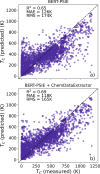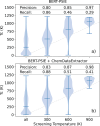A rule-free workflow for the automated generation of databases from scientific literature
- PMID: 38666056
- PMCID: PMC11041762
- DOI: 10.1038/s41524-023-01171-9
A rule-free workflow for the automated generation of databases from scientific literature
Abstract
In recent times, transformer networks have achieved state-of-the-art performance in a wide range of natural language processing tasks. Here we present a workflow based on the fine-tuning of BERT models for different downstream tasks, which results in the automated extraction of structured information from unstructured natural language in scientific literature. Contrary to existing methods for the automated extraction of structured compound-property relations from similar sources, our workflow does not rely on the definition of intricate grammar rules. Hence, it can be adapted to a new task without requiring extensive implementation efforts and knowledge. We test our data-extraction workflow by automatically generating a database for Curie temperatures and one for band gaps. These are then compared with manually curated datasets and with those obtained with a state-of-the-art rule-based method. Furthermore, in order to showcase the practical utility of the automatically extracted data in a material-design workflow, we employ them to construct machine-learning models to predict Curie temperatures and band gaps. In general, we find that, although more noisy, automatically extracted datasets can grow fast in volume and that such volume partially compensates for the inaccuracy in downstream tasks.
Keywords: Computational methods; Electronic structure.
© The Author(s) 2023, corrected publication 2024.
Conflict of interest statement
Competing interestsThe authors declare no competing interests.
Figures







References
-
- Bornmann L, Haunschild R, Mutz R. Growth rates of modern science: a latent piecewise growth curve approach to model publication numbers from established and new literature databases. Humanit. Soc. Sci. Commun. 2021;8:224. doi: 10.1057/s41599-021-00903-w. - DOI
-
- Curtarolo S, et al. Aflowlib.org: a distributed materials properties repository from high-throughput ab initio calculations. Comput. Mater. Sci. 2012;58:227–235. doi: 10.1016/j.commatsci.2012.02.002. - DOI
-
- Jain A, et al. Commentary: the materials project: a materials genome approach to accelerating materials innovation. APL Mater. 2013;1:011002. doi: 10.1063/1.4812323. - DOI
-
- Kirklin S, et al. The open quantum materials database (OQMD): assessing the accuracy of DFT formation energies. npj Comput. Mater. 2015;1:15010. doi: 10.1038/npjcompumats.2015.10. - DOI
